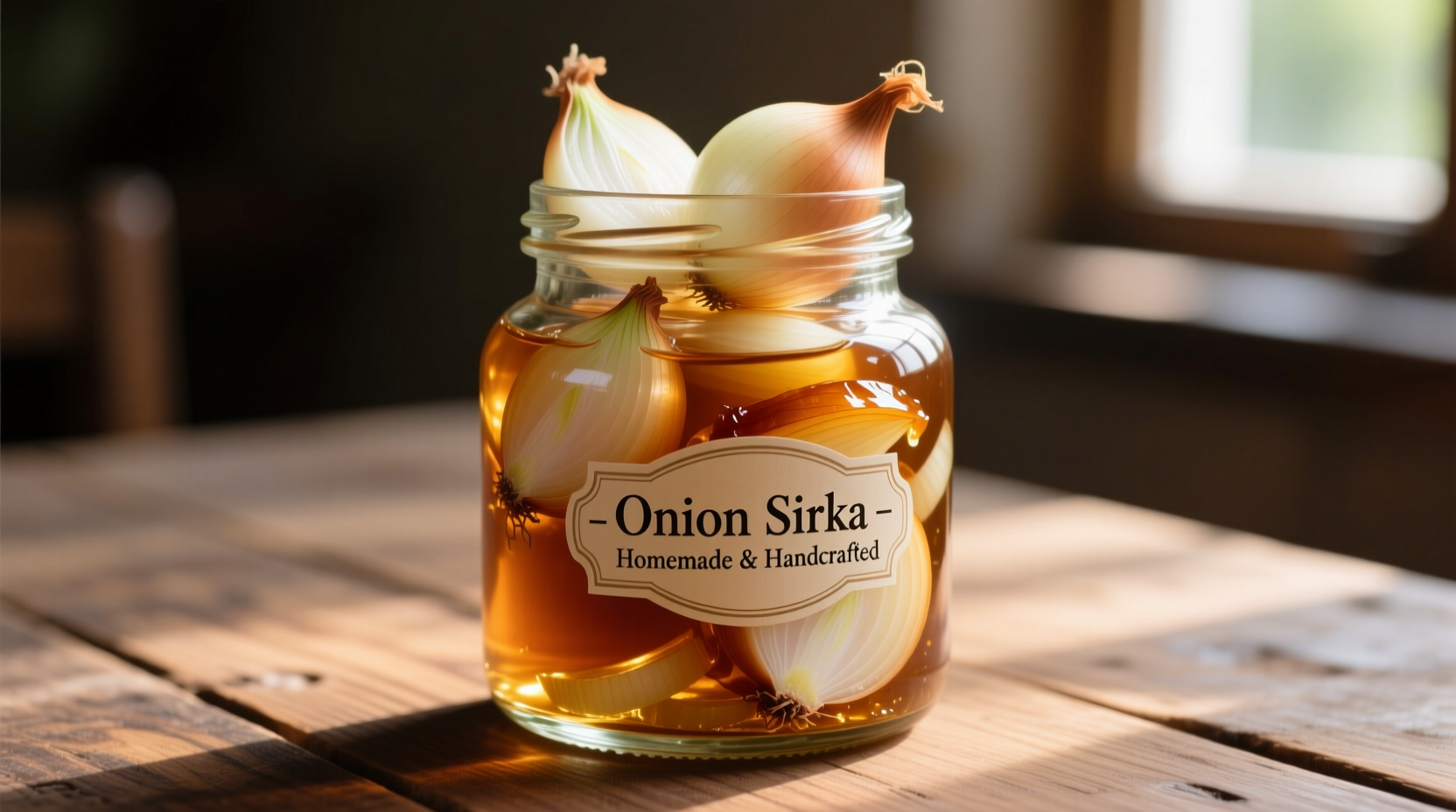Curious about onion sirka and how it can transform your cooking? This comprehensive guide reveals everything you need to know about this versatile culinary ingredient. You'll learn authentic preparation techniques used for generations, discover how to incorporate it into everyday meals, and understand why professional chefs consider it an essential component in flavor development. Whether you're a home cook looking to expand your pantry or a culinary enthusiast exploring traditional preservation methods, this guide provides practical, actionable information you can use immediately.
What Exactly Is Onion Sirka?
Onion sirka (also spelled "sirka" or "sirkeh") refers to vinegar that has been infused with onions, creating a complex flavor profile that combines the sharpness of vinegar with the sweet, savory notes of onions. The term "sirka" comes from Persian and Urdu, meaning vinegar, and has been used across South Asia, the Middle East, and parts of Africa for centuries.
Unlike commercial onion-flavored vinegars that may use artificial additives, traditional onion sirka is made through a natural infusion process where sliced onions steep in quality vinegar for several weeks. This slow extraction process creates a balanced condiment that enhances dishes without overwhelming them.
Historical Journey of Onion Vinegar Infusions
Onion sirka represents one of the oldest food preservation techniques known to humanity. Historical records show its use spans multiple civilizations:
| Time Period | Region | Documented Use |
|---|---|---|
| 3000 BCE | Mesopotamia | Earliest evidence of vinegar production; onions commonly added for flavor |
| 500 BCE | Ancient Greece | Hippocrates prescribed onion vinegar for digestive ailments |
| 1000 CE | Persian Empire | "Sirka" mentioned in culinary texts as essential cooking ingredient |
| 1500s | Mughal India | Onion sirka became staple in royal kitchens for marinades and chutneys |
| Present Day | Global | Traditional preparation methods preserved in home cooking worldwide |
According to research from the National Geographic Food History Project, onion-infused vinegars were particularly valuable before refrigeration, serving both as flavor enhancers and natural preservatives. The slow fermentation process creates beneficial compounds that extend shelf life while developing complex flavors.
Onion Sirka vs. Regular Vinegar: Key Differences
While both serve as acidic components in cooking, onion sirka offers distinct advantages over plain vinegar:
| Characteristic | Onion Sirka | Regular Vinegar |
|---|---|---|
| Flavor Profile | Complex sweet-savory notes with subtle onion undertones | Sharp, one-dimensional acidity |
| Culinary Applications | Marinades, salad dressings, chutneys, digestive tonics | General cooking, cleaning, pickling |
| Digestive Properties | Enhanced due to combined effects of onion and vinegar | Moderate digestive benefits |
| Preparation Time | 2-4 weeks for optimal flavor development | Immediately available |
| Shelf Life | 6-12 months when properly stored | Indefinite |
Food scientists at the University of Minnesota Extension note that the enzymatic compounds in onions interact with vinegar to create additional flavor compounds not present in regular vinegar. This chemical interaction produces a more rounded acidity that's less harsh on the palate while providing enhanced digestive benefits.
Authentic Onion Sirka Preparation Method
Creating genuine onion sirka requires patience and attention to detail. Here's the traditional preparation method used across South Asian households:
Ingredients You'll Need
- 1 cup quality apple cider vinegar or white vinegar
- 1 medium red onion, thinly sliced
- 1 teaspoon black peppercorns (optional)
- 1 small piece of ginger (optional)
- 1 dried red chili (optional)
- 1 teaspoon sugar or jaggery (optional)
Step-by-Step Process
- Clean and sterilize a glass jar with a tight-sealing lid
- Thinly slice one red onion (red onions provide the best color and flavor)
- Add onions to the jar, filling about one-third of the container
- Pour vinegar over onions until completely submerged
- Add optional ingredients for enhanced flavor complexity
- Seal the jar tightly and store in a cool, dark place
- Shake gently once daily for the first week
- Allow to infuse for 2-4 weeks (longer infusion creates stronger flavor)
- Strain through cheesecloth into a clean bottle for storage
Professional chefs recommend using red onions for their superior flavor profile and beautiful pink hue that develops during infusion. The resulting sirka will have a delicate pink color and a balanced flavor that's neither too sharp nor too sweet.
Practical Applications in Everyday Cooking
Understanding when and how to use onion sirka can elevate your cooking significantly. Here are the most effective applications:
Digestive Tonic
Mix one tablespoon of onion sirka with a glass of warm water and consume before meals. This traditional practice, documented in India's Ministry of AYUSH publications, helps stimulate digestive enzymes and can reduce bloating.
Marinade Enhancer
Replace regular vinegar in marinades with onion sirka for meats, particularly chicken and lamb. The enzymatic compounds help tenderize proteins while adding subtle flavor complexity. For best results, marinate for 2-4 hours before cooking.
Salad Dressing Base
Create a simple vinaigrette by combining 3 parts olive oil with 1 part onion sirka, plus salt and pepper. The natural sweetness of the infused vinegar eliminates the need for added sugar in most dressings.
Chutney Ingredient
Onion sirka serves as the perfect acidic component in fresh chutneys, balancing the sweetness of fruits like mango or tamarind. Traditional Indian recipes often use it in mint-coriander chutney for an extra flavor dimension.
Common Mistakes to Avoid
While making onion sirka seems straightforward, certain pitfalls can compromise quality. Understanding these context boundaries ensures optimal results:
- Using metal containers: Always use glass for preparation and storage, as vinegar reacts with metal
- Insufficient infusion time: Rushing the process (less than 2 weeks) results in harsh, unbalanced flavor
- Exposure to light: Store in dark place to prevent degradation of flavor compounds
- Overcrowding ingredients: Too many additional spices can overwhelm the delicate onion-vinegar balance
- Improper sealing: Inadequate sealing leads to evaporation and potential contamination
Food safety experts from the U.S. Food and Drug Administration emphasize that proper preparation and storage are crucial when making homemade infused vinegars. The acidic environment of vinegar (pH below 4.6) naturally inhibits harmful bacteria growth, but proper technique ensures safety and quality.
Creative Ways to Incorporate Onion Sirka
Expand your culinary repertoire with these innovative applications:
- Add a splash to lentil soups during the final minutes of cooking for brightness
- Use as a finishing touch on roasted vegetables for enhanced flavor complexity
- Mix with yogurt for a quick raita that aids digestion
- Create a quick pickling liquid for red onions by combining with equal parts water
- Add to homemade mayonnaise for a sophisticated sandwich spread

Preserving Traditional Knowledge
As industrial food production dominates modern kitchens, traditional preparation methods like onion sirka risk being forgotten. Culinary anthropologists note that these simple preservation techniques represent centuries of accumulated wisdom about flavor development and food safety.
By incorporating onion sirka into your cooking routine, you're not just enhancing flavors—you're participating in a culinary tradition that spans millennia. The slow, intentional process connects us to generations of cooks who understood that the best flavors develop with time and attention.
Final Thoughts
Onion sirka represents more than just a flavored vinegar—it's a bridge between traditional culinary wisdom and modern cooking practices. Its preparation requires minimal ingredients but delivers maximum flavor impact, making it accessible to cooks of all skill levels.
Whether you're looking to improve digestion, enhance your marinades, or simply add depth to everyday dishes, this traditional preparation offers practical solutions with historical significance. Start with a small batch, allow it the time it needs to develop properly, and soon you'll wonder how you ever cooked without it.











 浙公网安备
33010002000092号
浙公网安备
33010002000092号 浙B2-20120091-4
浙B2-20120091-4